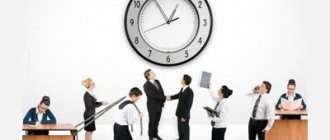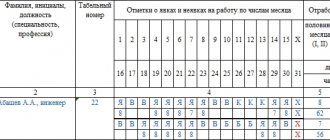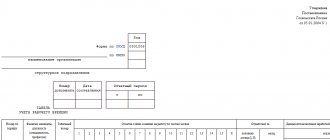Unified forms of accounting sheets
The Labor Code of the Russian Federation (Article 91) establishes the employer’s obligation to keep records of the time worked by employees. For this purpose, unified forms of time sheets are provided, approved by Resolution of the State Statistics Committee of January 5, 2004 No. 1. The use of these forms is not mandatory, therefore the employer has the right to develop his own. Form No. T-13 is used most often, as it is used for automated processing of credentials.
Order of the Ministry of Finance of the Russian Federation dated March 30, 2015 No. 52n approved the OKUD form 0504421 for use by public authorities (state bodies), local government bodies, management bodies of state extra-budgetary funds, state (municipal) institutions. The same Order defines the procedure for its completion and application.
Accounting software
Some organizations use special programs to monitor the time worked by employees. These programs provide automatic collection, storage and processing of information:
- about the presence of workers on site;
- arrival and departure times;
- period of work and rest, etc.
But in most organizations it is still customary to fill out the statement manually. This is not asceticism. Automated systems are expensive, but the old-style time sheet from 2004 is cheap. In addition, if the law allows you to change document forms for commercial organizations at your discretion, then the form for recording working hours in 2021 for public authorities (form 0504421), which we mentioned above, cannot be changed.
How to record time worked
For any length of the working day, regardless of the established modes, working time is reflected in the accounting table in two ways:
- method of continuous registration of attendance and absence from work;
- by recording only deviations (no-shows, overtime, etc.).
If the length of the working day (shift) is unchanged, it is allowed to register only deviations, since the terms of the employment contract or internal labor regulations determine the number of working hours for each working day.
If the number of hours worked on different days (shifts) is different, for example, when recording total time worked, then when filling out a time sheet, the continuous recording method should be used. This will allow, after the end of the accounting period, to identify possible overtime hours and adjust the employee’s further involvement in work within the limits of the norm for the length of time worked established for this category.
Notes on the working time sheet about the reasons for absence from work, part-time work or beyond its normal duration at the initiative of the employee or employer, shortened working hours, etc. are made on the basis of documents executed properly (certificate of incapacity for work, certificate of performance of state or public duties, a written warning about downtime, an application for part-time work, the employee’s written consent to work overtime in cases established by law, etc.).
What to put on your report card if your vacation falls on a holiday
In accordance with Art. 120 of the Labor Code of the Russian Federation, non-working holidays falling during the period of the annual main or annual additional paid leave are not included in the number of calendar days of leave and are not taken into account.
Holidays established by regional legislation are also excluded from vacation (see Resolution of the Presidium of the Supreme Court of the Russian Federation dated December 21, 2011 No. 20-ПВ11).
It follows that holidays falling on vacation in the report card must be designated by code “B” or 26.
And if you want, you can set your own code for this. This was indicated by the Ministry of Labor in letter No. 14-2/B-370 dated April 27, 2017.
How to designate non-working paid days if the employee was at home in self-isolation? The answer to this question is in ConsultantPlus. If you don't already have access to the system, get a trial online access for free.
How to fill out a time sheet
When compiling, you must be guided by the Instructions for the use and completion of forms of primary accounting documentation for recording labor and its payment, approved by Resolution of the State Statistics Committee of Russia dated January 5, 2004 No. 1. Special designations are used. When reflecting the amount of time worked, an alphabetic (I) or numeric (01) code is entered next to the employee’s last name, and the duration of work is indicated in the lower lines. If the work schedule falls at night, then complete the form with columns to indicate the necessary details.
If an employee is sent on a business trip, then the time he is on a business trip is marked by putting down an alphabetic (K) or numeric (06) code, and the duration of work is indicated in the lower lines. If, while on a business trip, the employee also worked on weekends, then on such days an alphabetic (РВ) or numeric (03) code is entered, and the duration of work is indicated in the lower lines.
We collected in the table the designations in the timesheet in form 0504421 in 2021.
| Event | Letter code | Digital code | |
| Duration of work during the day | I | 01 | |
| Duration of work at night | N | 02 | |
| Duration of work on weekends and non-working holidays | RV | 03 | |
| Overtime duration | WITH | 04 | |
| Duration of work on a rotational basis | VM | 05 | |
| Business trip | TO | 06 | |
| Advanced training without work | PC | 07 | |
| Advanced training with a break from work in another area | PM | 08 | |
| Annual basic paid leave | FROM | 09 | |
| Annual additional paid leave | OD | 10 | |
| Additional leave in connection with training while maintaining average earnings for employees combining work with training | U | 11 | |
| Reduced working hours for on-the-job trainees with partial pay retention | UV | 12 | |
| Additional leave in connection with training without pay | UD | 13 | |
| Maternity leave (leave in connection with the adoption of a newborn child) | R | 14 | |
| Parental leave until the child reaches the age of three | coolant | 15 | |
| Unpaid leave granted to an employee with the permission of the employer | BEFORE | 16 | |
| Leave without pay under the conditions provided for by the current legislation of the Russian Federation | OZ | 17 | |
| Additional annual leave without pay | DB | 18 | |
| Temporary disability (except for cases provided for by code “T”) with the assignment of benefits in accordance with the law | B | 19 | |
| Temporary disability without benefits in cases provided for by law | T | 20 | |
| Reduced working hours versus normal working hours in cases provided for by law | Champions League | 21 | |
| Time of forced absence in the event of dismissal, transfer to another job or suspension from work being declared illegal, with reinstatement to the previous job | PV | 22 | |
| Absenteeism while performing state or public duties in accordance with the law | G | 23 | |
| Absenteeism (absence from the workplace without good reason for the time established by law) | ETC | 24 | |
| Duration of part-time work at the initiative of the employer in cases provided for by law | NS | 25 | |
| Weekends (weekly vacation) and non-working holidays | IN | 26 | |
| Additional days off (paid) | OB | 27 | |
| Additional days off (without pay) | NV | 28 | |
| Strike (under conditions and in the manner prescribed by law) | ZB | 29 | |
| Absences for unknown reasons (until the circumstances are clarified) | NN | 30 | |
| Downtime caused by the employer | RP | 31 | |
| Downtime due to reasons beyond the control of the employer and employee | NP | 32 | |
| Downtime due to employee fault | VP | 33 | |
| Suspension from work (preclusion from work) with payment (benefits) in accordance with the law | BUT | 34 | |
| Suspension from work (preclusion from work) for reasons provided for by law, without accrual of wages | NB | 35 | |
| Time of suspension of work in case of delay in payment of wages | NZ | 36 | |
Format for filling out a working time sheet in T-13
Unlike arbitrary tables of similar content, T-13 contains data about the enterprise, including the form of ownership and OKPO. The document number is entered in accordance with internal requirements for maintaining timesheets.
The department name is also shown at the top. It must be remembered that the head of this department (even if filling out the time sheet is not his or her responsibility) must sign the completed form.
The order of employees is determined by the decision of the person in charge. Most often, alphabetical sorting is found, as in our example, but the option of arranging by personnel number is possible (column 3).
In column 4 we put marks by day:
I - (appearance) working day, B - day off, FROM - vacation, RP - attendance on a day off (working out), K - business trip, PC - advanced training, U - study leave with a call from an educational institution, B - sick leave with sick leave sheet, T - unpaid sick leave without sick leave.
Under the I mark we put the number of hours worked that day. In column 5 we summarize the number of I in the line and the number of hours. We get 4 values for 2 halves of the month. In column 6 we sum up the values and get the final figure for the work for the month.
The number of hours for B, OT, K, B and other cases is not indicated in the fourth column. For this there are columns 10-13.
Accounting for sick leave, vacations or absences for other reasons
Designation codes may be different (for example, numeric). There is no specific format required by law.
The notation X shows that we are not taking this day into account: for convenience, the month is divided into two lines with unequal values. For months with 30 days (for example, November, the column will look like this (for convenience, the “non-existent” 31st number is highlighted in red):
T-13 for November
By analogy, T-13 is filled out for visits in February.
Columns 7-9 indicate the payment code, number of days and type of charges. Our example uses the following codes:
- 2000 - Common workday,
- 2300 – sick leave (disability benefit),
- 2012 - vacation.
Alternative solution
Some enterprises approve a slightly simplified version of the time sheet without detailing the reasons for omissions. Column 4 indicates only 2 codes:
- I am a working day
- N - unworked day.
This method may be inconvenient because it does not record sick leave.
Special cases
- How to fill out T-13 for employees participating in conferences and other training events?
- Can code I have a value of more than 8 hours?
- What is the difference between report cards T-12 and T-13?
Depends on the position of the enterprise. These days can be counted as working days (I), or as advanced training (PC). Pay rates may also vary.
Yes. Maybe if there is a special order about extended working hours. Overtime hours can be marked with the symbol C.
The first is a manual attendance form. The second is electronic. Many accounting departments today have switched to T-13, since it can be automatically collected using a special program.
Weekends and holidays in the report card
They are reflected in accordance with the production calendar, which takes into account all established holidays and their transfers in accordance with Government Decrees. Days off for different categories of employees vary depending on the work schedule established for them. The document uses different holiday accounting codes. It depends on how the organization pays for these days and on what basis they are provided.
A day off in accordance with the employee’s schedule is indicated by a letter (B) or numeric (26) code. It does not affect the established wages.
If, at the initiative of the company, employees receive an additional day off, and the company reduces the monthly work rate for them, then the employees receive a full salary, and these days are not paid by the company. For such days, the timesheet contains an alphabetic (B) or numeric (26) code.
Another case of a company establishing an additional day off is when employees go on a day off, and the company pays for these days according to the average. It turns out that workers receive a salary for days worked, and an average salary for additional paid days off. For such a case, an alphabetic (OB) or numeric (27) code is provided.
Forms of report cards and their differences
Working hours must be recorded regardless of the organizational and legal form and size of the staff, as stated in Part 4 of Art. 91 of the Labor Code of the Russian Federation.
For this, the following forms can be used - No. T-12 and No. T-13.
They were approved by Resolution of the State Statistics Committee of the Russian Federation 01/05/2004 No. 1 “On approval of unified forms of primary accounting documentation for recording labor and its payment.” The forms have the same purpose, but have the following differences:
1. Form No. T-13 is primarily used for recording working hours in an automated mode, therefore it is used in companies and institutions where a special turnstile is installed - an automatic system that controls the attendance of workers.
sample form No. T-13 archived in .xls format (Microsoft Excel) 2. Form No. T-12 is primarily used for recording working hours on paper and is considered a universal document.
sample form No. T-12 in the archive in .doc format (Word) 3. In form No. T-12, there is “Section 2” with columns for data on wages, which is not present in form No. T-13;
If the company maintains settlements with personnel as a separate type of accounting, then the second section of form No. T-12 can be left blank.
If necessary, changes can be made to the unified forms, but this will require initially issuing an appropriate order. It should be taken into account that you can only add columns to the document, but you cannot delete them.
Timesheet forms No. T-12 and No. T-13 are optional for use from January 1, 2013, so individual entrepreneurs and organizations can use other methods of monitoring the time employees spend at the workplace. In fact, the forms developed by Goskomstat are quite convenient and are still used everywhere.
Storage period for time sheets
Such an accounting table is a personnel document relating to the organization of labor, for which Art. 22.1 of the Law on Archival Affairs establishes a special storage period, namely:
- five years from the end of the year in which it was compiled, if the time sheet took into account only the work of those employees who work under normal working conditions;
- 50 years from the date of drawing up the TURV, if it took into account the work of employees engaged in harmful or dangerous work.
The nuances of drawing up a working time schedule
The approach to charting is as follows:
- determine the period for drawing up the schedule (week, month, quarter, year);
- if the company has established different working hours for different employees, it is necessary to break down the members of the workforce according to the working hours applied (five-day, six-day, flexible days off, etc.);
- calculate the standard working time for each mode used in the company;
- group working time in combination with days of rest, taking into account the legally established requirement for the duration of a weekly continuous 42-hour rest (Article 110 of the Labor Code of the Russian Federation).
For example, in a company some employees work from Monday to Friday on an 8-hour workday. At the same time, the work is performed not only by adult workers, but also by teenagers aged 15–16 years. Considering that they have a different working day, for this age group it is necessary to calculate the annual working time as follows:
- clarify the legislative standard for the length of the working week for this category of workers: no more than 24 hours;
- calculate the length of the working day: 24 hours per week / 5 working days = 4.8 hours;
- determine the standard working time for this group of workers: 248 working days × 4.8 hours – 5 hours of pre-holiday shortfalls = 1,185.4 hours.
For the rest of the employees of this company, when working on a five-day schedule, the standard working time will be: 8 hours × 247 working days – 4 hours = 1,972 hours.
IMPORTANT! The standard working time is reduced by the total length of breaks in the performance of labor functions: vacations, sick leave, donor days and other similar time intervals when the employee does not work.
You can order an order to change the work schedule by following the link.
Accounting and taxes
Based on the data indicated in the table, the accounting department calculates wages and various benefits. This data also affects the payment of taxes. Let's pay attention to the main risks.
When passing tax audits, including income tax, the company must provide reliable data on the number of days and hours worked by each employee in order to confirm the correctness of the accruals. If violations are discovered, the amount of income tax indicated in the reports will be recognized as incorrect, which will entail the imposition of penalties.
When withholding personal income tax from an employee’s earnings, the organization, as a tax agent, must find out whether this person is a tax resident of the Russian Federation in order to use the correct tax rate in the calculation. The report card will be able to confirm the actual presence of the employee in the country. This feature should especially be taken into account by those employers who send employees on business trips to Belarus or Kazakhstan, because when crossing these borders, no marks are made in the citizen’s passport. If a dispute arises, the company will be able to prove that it applied the correct rate, withheld and charged personal income tax in full.
Correctly filling out the timesheet guarantees the company the ability of the Social Insurance Fund to count expenses on sick leave, because it is impossible to officially confirm the number of days worked, which are extremely important when calculating these amounts.
General rules for keeping timesheets
The accounting register must be opened on the first working day of the month, and it is drawn up from the first calendar day (even if the month begins on a weekend or holiday). At the end of the month the timesheet is closed. Some companies record interim results after the 15th, but only if production needs require it.
The key principles for maintaining this document must be declared in local regulations (for example, in the standard provision on time sheets). And the employee responsible for the time sheet must be guided by these regulations. Here it is worth clarifying and consolidating certain important points:
- The timesheet can be kept for individual structural divisions or for the company as a whole (the main thing is to determine this point immediately).
- The accounting must define coding by type of working/non-working time.
- The time sheet must reflect not only the hours worked, but also the time during which the employee did not carry out his work duties, although he should have done so (absenteeism, violation of labor discipline in the form of absence from the workplace, early leaving, downtime, etc.) .
- Each employee begins to appear on the timesheet strictly after it is registered in personnel records - there is an employment order, an employment agreement is signed. Similarly, employees are excluded from the time sheet - after the dismissal order comes into force.
- As soon as an employee is included in the time sheet, he is assigned a personnel number. Moreover, this number does not change throughout his employment in the company. If a person moves to another position, his personnel number remains the same. And even after an employee’s dismissal, his number cannot be assigned to anyone for another three years.
- Entering data into the timesheet in advance is strictly prohibited. It can only be filled in after the fact. Even if the timekeeper is sure, for example, that on the last day of the month everyone is already at work, it is not a fact that everyone will work the required 8 hours. Therefore, correct execution of the timesheet requires filling it out only the next day after a month has passed.
Methods for filling out the timesheet
There are actually 3 ways to maintain a timesheet:
- electronic;
- using automated accounting;
- on paper.
Of course, today the electronic method is used most often. Here you can always make adjustments, because there are often situations when the timesheet has to be corrected.
The most common simple accounting option today is to maintain a timesheet virtually manually in Excel. This method allows you to use entered formulas to calculate indicators, summarize them, and keep a timesheet throughout the year in a single file. Here you can keep statistics both for a specific employee, and for a division, and for the company as a whole. But still, this is a rather labor-intensive process for the timekeeper, which needs to be done regularly.
A more convenient and efficient way to maintain timesheets is to work through the 1C system. It also makes it possible to make adjustments to the electronic document. As a rule, internal online accounting is associated with a access system.
At large enterprises, even in order to go out for lunch, you need to check in, and the amount of time worked is automatically recorded in the time sheet
At large enterprises, especially in production, electronic systems for recording and monitoring employee working time are successfully used. Every second is recorded when an employee enters the enterprise and when he leaves. The most common types of such online surveillance include:
- electronic pass, when an employee, passing through the terminal, swipes a card, after reading the code on it, the information goes directly into the accounting program;
- there are terminals that can only be passed using a fingerprint (a more serious method, because the electronic card can also be given to another person for duty);
- retinal scanning - maximum degree of protection;
- video surveillance of workers, which allows, among other things, to monitor the production process itself;
- turning on and starting an employee’s work on a computer or going online or Skype (this is especially true for IT companies and Internet workers, including remote workers);
- recording telephone conversations (start/end) - for call center operators or online stores.
Such automated accounting allows you to eliminate the human factor and systematize the process.
Data from the online control system immediately enters the common database and forms a time sheet in real time. To the point that the immediate manager can see at any time: what time his subordinate came to work, what he did at the workplace and how many times he logged into social media. networks. Some systems allow you to generate an employee working time card.
The main thing here is that the use of any of the online control methods must be documented in the internal regulations, as well as in the labor contracts of employees. Only in this case is the use of any type of monitoring of the work process legal.











